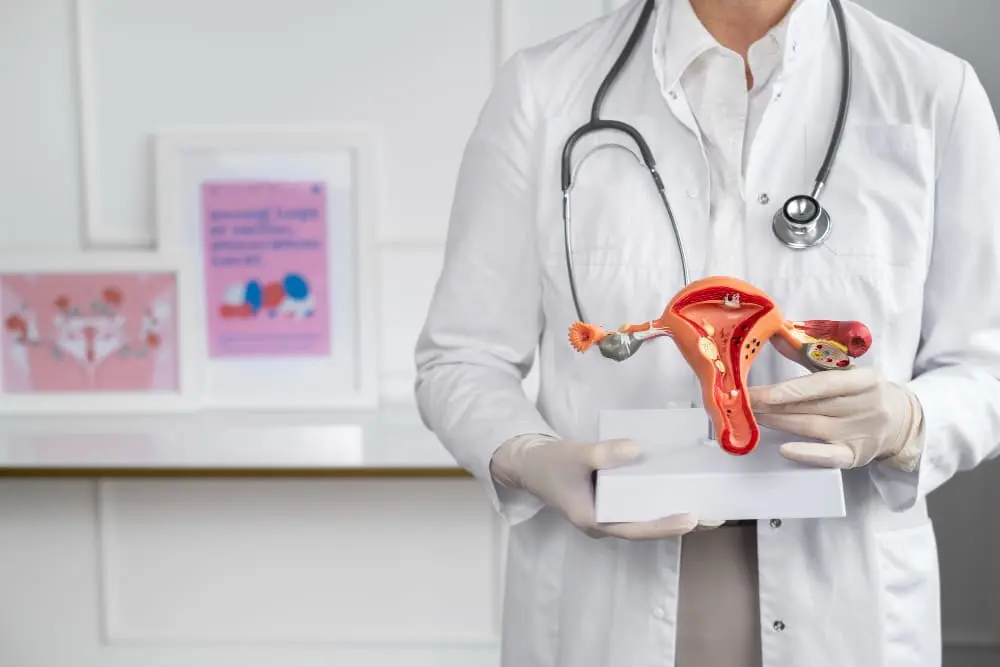Endometriosis and Its Impact on Fertility
Endometriosis is a complex and often misunderstood condition that affects millions of women worldwide. It occurs when the tissue similar to the lining inside the uterus, known as the endometrium, starts to grow outside the uterus. This abnormal growth can lead to severe pain, heavy periods, and, in many cases, fertility problems. In this article, we will explore what endometriosis is, how it impacts fertility, and the options available for women who are struggling to conceive.
Understanding Endometriosis
Endometriosis is a chronic condition where the endometrial tissue grows in places it shouldn’t, such as the ovaries, fallopian tubes, and the pelvic lining. In rare cases, it can also spread beyond the pelvic area. This tissue behaves like regular endometrial tissue during the menstrual cycle – it thickens, breaks down, and bleeds. However, since it has no way to exit the body, it becomes trapped, causing irritation and the formation of scar tissue and adhesions. These adhesions can cause organs to stick together, leading to severe pain and other complications.
Symptoms of Endometriosis
The symptoms of endometriosis can vary widely among women. Some may experience severe symptoms, while others have mild or none at all. The most common symptoms include:
Pelvic Pain: Often the most prominent symptom, pelvic pain usually worsens during menstruation.
Heavy Periods: Many women with endometriosis experience heavy menstrual bleeding or bleeding between periods.
Painful Intercourse: Pain during or after sex is common among those with endometriosis.
Pain with Bowel Movements or Urination: These symptoms are more likely to occur during a woman’s period.
Infertility: Endometriosis is sometimes first diagnosed in women seeking treatment for infertility.
How Endometriosis Affects Fertility
Endometriosis can impact fertility in several ways. The severity of the condition often correlates with the degree of infertility. Here are some ways endometriosis can affect a woman’s ability to conceive:
Distorted Anatomy of the Pelvis
The presence of endometriosis can lead to the formation of scar tissue and adhesions, which can distort the normal anatomy of the pelvis. This distortion can affect the ovaries, fallopian tubes, and the pelvic cavity, making it difficult for the egg to travel through the fallopian tube and meet the sperm.
Inflammation and Immune System Dysfunction
Endometriosis can cause inflammation in the pelvic area, leading to an overactive immune response. This can negatively impact the eggs, sperm, and embryo, hindering the fertilization process and implantation.
Hormonal Imbalances
Women with endometriosis may experience hormonal imbalances that can interfere with ovulation. This can result in irregular menstrual cycles and reduce the chances of successful conception.
Impaired Egg Quality
The inflammation and hormonal changes associated with endometriosis can affect the quality of the eggs produced by the ovaries. Poor egg quality can decrease the likelihood of successful fertilization and implantation.
Tubal Blockage
Endometriosis can cause the fallopian tubes to become blocked or damaged. Blocked fallopian tubes prevent the egg and sperm from meeting, making natural conception impossible.
Diagnosing Endometriosis
Diagnosing endometriosis can be challenging, as its symptoms often mimic those of other conditions. A combination of medical history, physical exams, and diagnostic tests is typically used to confirm the presence of endometriosis.
Medical History and Physical Exam
Doctors will start by taking a detailed medical history and conducting a pelvic exam to check for signs of endometriosis, such as cysts or tender areas in the pelvis.
Imaging Tests
Ultrasound, MRI, and other imaging tests can help identify endometriomas (endometriosis cysts) and other abnormalities. However, these tests cannot definitively diagnose endometriosis, as they may not detect small lesions.
Laparoscopy
The most definitive way to diagnose endometriosis is through laparoscopy. This minimally invasive surgical procedure involves inserting a camera through a small incision in the abdomen to visualize and possibly biopsy endometrial tissue.
Treatment Options for Endometriosis
While there is no cure for endometriosis, several treatments can help manage its symptoms and improve fertility. The treatment plan depends on the severity of the symptoms, the extent of the disease, and the patient’s desire to conceive.
Pain Management
Pain management is a crucial aspect of endometriosis treatment. Over-the-counter pain relievers, such as ibuprofen and naproxen, can help alleviate mild to moderate pain. For more severe pain, doctors may prescribe stronger medications.
Hormonal Therapies
Hormonal therapies can help reduce or eliminate menstruation, thus decreasing the growth and spread of endometrial tissue. Common hormonal treatments include:
Birth Control Pills: These can help regulate the menstrual cycle and reduce pain.
Gonadotropin-Releasing Hormone (GnRH) Agonists: These medications temporarily halt menstruation and lower estrogen levels, shrinking endometrial tissue.
Progestin Therapy: This includes pills, injections, or intrauterine devices (IUDs) that reduce or eliminate menstruation.
Surgical Treatment
Surgery may be necessary for women with severe endometriosis or those who do not respond to other treatments. Laparoscopic surgery can remove endometrial growths, scar tissue, and adhesions, improving pain and fertility outcomes. In severe cases, a hysterectomy (removal of the uterus) may be recommended, though this is typically considered a last resort.
Fertility Treatments
For women struggling to conceive due to endometriosis, several fertility treatments are available:
Ovulation Induction: Medications are used to stimulate the ovaries to produce multiple eggs, increasing the chances of conception.
Intrauterine Insemination (IUI): Sperm is directly placed into the uterus, bypassing any blockages or adhesions in the fallopian tubes.
In Vitro Fertilization (IVF): Eggs are retrieved from the ovaries, fertilized with sperm in a lab, and the resulting embryos are implanted into the uterus. IVF is often the most effective fertility treatment for women with endometriosis.
Coping with Endometriosis and Infertility
Living with endometriosis and infertility can be emotionally and physically challenging. Here are some tips to help cope with the condition:
Seek Support
Connecting with others who understand what you’re going through can be incredibly helpful. Support groups, whether in-person or online, offer a space to share experiences and gain emotional support.
Educate Yourself
Understanding your condition can empower you to make informed decisions about your treatment. Stay updated on the latest research and treatment options.
Practice Self-Care
Managing stress and taking care of your overall well-being is crucial. Regular exercise, a balanced diet, and mindfulness practices can help reduce stress and improve your quality of life.
Communicate with Your Partner
Open communication with your partner about your feelings and challenges is essential. Consider seeking couples counseling if endometriosis and infertility are straining your relationship.
Consult a Fertility Specialist
If you’re struggling to conceive, consulting a fertility specialist can provide you with a tailored treatment plan. They can offer advanced fertility treatments and guide you through the process.
Conclusion
Endometriosis is a challenging condition that can significantly impact a woman’s fertility. Understanding how it affects fertility and the available treatment options can help women make informed decisions about their reproductive health. While the journey with endometriosis and infertility can be tough, support and advanced medical treatments can offer hope and improve outcomes. If you suspect you have endometriosis or are struggling with infertility, seek medical advice to explore your options and receive the care you need.








